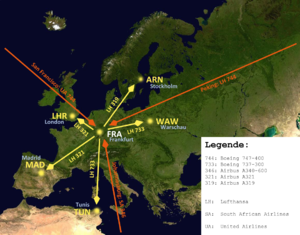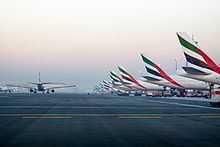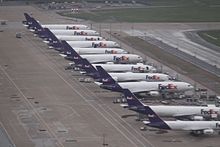Airline hub

Anairline huborhub airportis anairportused by one or moreairlinesto concentrate passenger traffic and flight operations. Hubs serve as transfer (or stop-over) points to help get passengers to their final destination.[a][b]It is part of thehub-and-spoke system.An airline may operate flights from several non-hub (spoke) cities to the hub airport, and passengers traveling between spoke cities connect through the hub. This paradigm createseconomies of scalethat allow an airline to serve (via an intermediate connection) city-pairs that could otherwise not be economically served on anon-stopbasis. This system contrasts with thepoint-to-point model,in which there are no hubs and nonstop flights are instead offered between spoke cities. Hub airports also serve origin and destination (O&D) traffic.
Operations[edit]

The hub-and-spoke system allows an airline to serve fewer routes, so fewer aircraft are needed.[3]The system also increases passenger loads; a flight from a hub to a spoke carries not just passengers originating at the hub, but also passengers originating at multiple spoke cities.[4]However, the system is costly. Additional employees and facilities are needed to cater to connecting passengers. To serve spoke cities of varying populations and demand, an airline requires several aircraft types, and specific training and equipment are necessary for each type.[3]In addition, airlines may experience capacity constraints as they expand at their hub airports.[4][5]
For the passenger, the hub-and-spoke system offers one-stop air service to a wide array of destinations.[3][6]However, it requires having to regularly make connections en route to their final destination, which increases travel time.[6]Additionally, airlines can come to monopolise their hubs (fortress hubs), allowing them to freely increase fares as passengers have no alternative.[4]High domestic connectivity in the United States is achieved through airport location and hub dominance. The top 10 megahubs in the US are dominated byAmerican Airlines,Delta Air LinesandUnited Airlines,the three largest United States-based airlines.[7]
Banking[edit]
Airlines may operate banks of flights at their hubs, in which several flights arrive and depart within short periods of time. The banks may be known as "peaks" of activity at the hubs and the non-banks as "valleys". Banking allows for short connection times for passengers.[8]However, an airline must assemble many resources to cater to the influx of flights during a bank, and having several aircraft on the ground at the same time can lead to congestion and delays.[9]In addition, banking could result in inefficient aircraft utilisation, with aircraft waiting at spoke cities for the next bank.[9][10]
Instead, some airlines have debanked their hubs, introducing a "rolling hub" in which flight arrivals and departures are spread throughout the day. This phenomenon is also known as "depeaking".[10]While costs may decrease, connection times are longer at a rolling hub.[9]American Airlineswas the first to depeak its hubs,[9]trying to improve profitability following theSeptember 11 attacks.[8]It rebanked its hubs in 2015, however, feeling the gain in connecting passengers would outweigh the rise in costs.[8]
For example, the hub ofQatar AirwaysinDoha Airporthas 471 daily movements to 140 destinations by March 2020 with an average of 262 seats per movement; in three main waves: 05:00–09:00 (132 movements), 16:00–21:00 (128) and 23:00–03:00 (132), allowing around 30 million connecting passengers in 2019.[11]
History[edit]
United States[edit]
Before the US airline industry wasderegulatedin 1978, most airlines operated under thepoint-to-point system(with a notable exception beingPan Am).[4]TheCivil Aeronautics Boarddictated which routes an airline could fly. At the same time, however, some airlines began to experiment with the hub-and-spoke system.Delta Air Lineswas the first to implement such a system, providing service to remote spoke cities from itsAtlantahub.[6]After deregulation, many airlines quickly established hub-and-spoke route networks of their own.[3]
| Airport | Region[citation needed] | 2022 pax. | AA | DL | UA | WN |
|---|---|---|---|---|---|---|
| Atlanta | South | 45.37 | 33.87 | 3.68 | ||
| Dallas/Fort Worth | South | 35.33 | 24.34 | |||
| Denver | West | 33.75 | 12.34 | 10.43 | ||
| Chicago–O'Hare | Midwest | 33.13 | 7.71 | 11.13 | ||
| Los Angeles | West | 32.29 | 4.91 | 5.42 | 4.74 | 3.21 |
| New York–JFK | Northeast | 26.99 | 3.37 | 6.23 | ||
| Las Vegas | West | 25.26 | 8.87 | |||
| Orlando | South | 24.44 | 4.79 | |||
| Miami | South | 23.68 | 13.93 | |||
| Charlotte | South | 23.09 | 16.14 | |||
| Seattle[c] | West | 22.11 | 4.47 | |||
| Phoenix | West | 21.79 | 7.39 | 7.62 | ||
| Newark | Northeast | 21.66 | 12.15 | |||
| San Francisco | West | 20.40 | 8.50 | |||
| Houston–Intercontinental | South | 19.80 | 11.08 | |||
| Boston | Northeast | 15.42 | 3.26 | |||
| Fort Lauderdale | South | 15.36 | ||||
| Minneapolis | Midwest | 15.20 | 8.52 | |||
| New York–LaGuardia | Northeast | 14.36 | 2.49 | 2.92 | ||
| Detroit | Midwest | 13.73 | 7.95 |
Middle East[edit]

In 1974, the governments ofBahrain,Oman,Qatarand theUnited Arab Emiratestook control ofGulf Airfrom theBritish Overseas Airways Corporation(BOAC). Gulf Air became theflag carrierof the four Middle Eastern nations. It linked Oman, Qatar and the UAE to its Bahrain hub, from which it offered flights to destinations throughout Europe and Asia. In the UAE, Gulf Air focused onAbu Dhabirather thanDubai,contrary to the aspirations of UAE Prime MinisterMohammed bin Rashid Al Maktoumto transform the latter into a world-class metropolis. Sheikh Mohammed proceeded to establish a new airline based in Dubai,Emirates,which launched operations in 1985.[15]
Elsewhere in the Middle East region, Qatar and Oman decided to create their own airlines as well.Qatar AirwaysandOman Airwere both founded in 1993, with hubs atDohaandMuscatrespectively. As the new airlines grew, their home nations relied less on Gulf Air to provide air service. Qatar withdrew its share in Gulf Air in 2002. In 2003, the UAE formed another national airline,Etihad Airways,which is based in Abu Dhabi. The country exited Gulf Air in 2006, and Oman followed in 2007.[15]Gulf Air therefore became fully owned by the government of Bahrain.
Emirates,Qatar Airways,SaudiaandEtihad Airwayshave since established large hubs at their respective home airports. The hubs, which benefit from their proximity to large population centres,[15]have become popular stopover points on trips between Europe and Asia, for example.[16]Their rapid growth has impacted the development of traditional hubs, such asLondon-Heathrow,Paris-Charles de Gaulle,andNew York-JFK.[17]
Types of hubs[edit]

Cargo hubs and scissor hubs[edit]
Acargo hubis an airport that primarily is operated by acargo airlinethat uses the hub-and-spoke system. In theUnited States,two of the largest cargo hub airports,FedEx'sMemphis SuperhubandUPSLouisville Worldport,are close to themean center of the United States population.FedEx's airline,FedEx Express,established its Memphis hub in 1973, prior to the deregulation of the air cargo industry in the United States. The system has created an efficient delivery system for the airline.[18]UPS Airlineshas followed a similar pattern in Louisville. In Europe,ASL Airlines,CargoluxandDHL Aviationfollow a similar strategy and operate their primary hubs atLiège,LuxembourgandLeipzigrespectively.[19]
Additionally,Ted Stevens International AirportinAnchorage, Alaska,is a frequent stop-over hub for many cargo airlines flying between Asia and North America. Most cargo airlines only stop in Anchorage for refueling and customs, but FedEx and UPS frequently use Anchorage to sort trans-pacific packages between regional hubs on each continent in addition to refueling and customs.[20]
Passenger airlines that operate in a similar manner to the FedEx and UPS hubs are often regarded asscissor hubs,as many flights to one destination all land and deplane passengers simultaneously and, after a passenger transit period, repeat a similar process for departure to the final destination of each plane.[21]In past,Air Indiaoperated a scissor hub at London'sHeathrow Airport,where passengers fromDelhi,Ahmedabad,andMumbaicould continue onto a flight toNewark.[22]Until its grounding,Jet Airwaysoperated a similar scissor hub atAmsterdam Airport Schipholto transport passengers fromBangalore,MumbaiandDelhitoToronto-Pearsonand vice versa. At the peak of operations at their former scissor hub atBrusselsprior to the 2016 shift to Schiphol, flights operated from Mumbai, Delhi, andChennaiand continued onward to Toronto,New York,andNewarkafter a near-simultaneous stopover in Brussels and vice versa.[23]An international scissor hub could be used forthird and fourth freedomflights or it could be used forfifth freedomflights, for which a precursor is abilateral treatybetween two country pairs.
WestJetused to utilizeSt. John'sas a scissor hub during its summer schedule for flights inbound fromOttawa,Toronto,andOrlandoand outbound toDublinandLondon–Gatwick.Qantassimilarly used to utilizeLos Angeles International Airportas a scissor hub for flights inbound from Melbourne, Brisbane or Sydney, where passengers could connect onwards if traveling toNew York–JFK.
Focus city[edit]

In theairlineindustry, afocus cityis a destination from which an airline operates limitedpoint-to-pointroutes.[25]A focus city primarily caters to the local market rather than to connecting passengers.[26][27]
Although the termfocus cityis used to mainly refer to an airport from which an airline operates limited point-to-point routes, its usage has loosely expanded to refer to a small-scale hub as well.[28]For example, even thoughJetBlue's operations atNew York–JFKresemble that of a hub, the airline still refers to it as a focus city.[9]
Fortress hub[edit]
A fortress hub exists when an airline controls a significant majority of the market at one of its hubs. Competition is particularly difficult at fortress hubs.[29]As of 2012[update],examples includedDelta Air LinesatAtlanta,Detroit,Minneapolis/St. PaulandSalt Lake City;American AirlinesatCharlotte,Dallas Fort Worth,Miami,andPhiladelphia;andUnited AirlinesatHouston–Intercontinental,NewarkandWashington-Dulles.[30]
Flag carriershave historically enjoyed similar dominance at the main international airport of their countries and some still do. Examples includeAeromexicoinMexico City,Air CanadainToronto–Pearson,Air FranceinParis–Charles de Gaulle,British AirwaysinLondon–Heathrow,Cathay PacificinHong Kong,Copa AirlinesinPanama City,EmiratesinDubai,Ethiopian AirlinesinAddis Ababa,FinnairinHelsinki,IberiainMadrid,Japan AirlinesinTokyo-Haneda,Iran AirinImam Khomeini,ITA AirwaysinRome,AeroflotinSheremetyevo,Korean AiratSeoul–Incheon,KLMinAmsterdam,LufthansainFrankfurt,QantasinSydney,Qatar AirwaysinDoha,Singapore AirlinesinSingapore,South African AirwaysinJohannesburg,Swiss International Air LinesinZurich,Turkish AirlinesinIstanbul,WestJetinCalgaryandAegean AirlinesinAthens.
Primary and secondary hubs[edit]
A primary hub is the main hub for an airline. However, as an airline expands operations at its primary hub to the point that it experiences capacity limitations, it may elect to open secondary hubs. Examples of such hubs areAir Canada's hubs atMontréal–TrudeauandVancouver,British Airways' hub atLondon–Gatwick,Air India's hub atMumbaiandLufthansa's hub atMunich.By operating multiple hubs, airlines can expand their geographic reach.[31]They can also better serve spoke–spoke markets, providing more itineraries with connections at different hubs.[1]
Cargo airlines likeFedEx ExpressandUPS Airlinesalso operate secondary hubs to an extent, but these are primarily used to serve regional high-demand destinations because shipping packages through its main hub would waste fuel; an example of this would be FedEx transiting a package throughOakland International Airportwhen shipping packages between destinations nearSeattleandPhoenix, Arizonainstead of sending deliveries through theMemphis Superhub.[20]
Reliever hub[edit]
A given hub's capacity may become exhausted or capacity shortages may occur during peak periods of the day, at which point airlines may be compelled to shift traffic to a reliever hub. A reliever hub has the potential to serve several functions for an airline: it can bypass the congested hub, it can absorb excess demand for flights that could otherwise not be scheduled at the congested hub, and it can schedule new O&D city pairs for connecting traffic.
One of the most recognized examples of this model isDelta Air Lines' andAmerican Airlines' uses ofLaGuardia Airportas a domestic hub inNew York City,due to capacity and slot restrictions at their hubs atJohn F. Kennedy International Airport.Many regional flights operate out of LaGuardia, while most international and long-haul domestic flights remain at JFK.
Lufthansaoperates a similar model of business with its hubs atFrankfurt AirportandMunich Airport.Generally speaking, a marginal majority of the airline's long-haul flights are based out of Frankfurt, while a similarly-sized but smaller minority are based out of Munich.
Moonlight hub[edit]
In past history, carriers have maintained niche, time-of-day operations at hubs. The most notable wasAmerica West's use ofMcCarran International Airport(now named after longtime Nevada SenatorHarry Reid) in Las Vegas as a primary night-flight hub to increase aircraft utilization rates far beyond those of competing carriers.
See also[edit]
- Hidden city ticketing
- List of former airline hubs
- List of hub airports
- Point-to-point transit
- Transport hub
Notes[edit]
- ^Colloquially, an airline hub may be defined as an airport that receives many passengers or as an airport that serves as the operating base of an airline, whether or not the airline allows for connecting traffic.[1]
- ^TheFederal Aviation Administrationof the United States defines a hub in terms of passenger enplanements. Specifically, a hub is an airport that handles 0.05% or more of the nation's annual passenger boardings.[1][2]
- ^Alaska Airlines:11.4[14]
References[edit]
- ^abcHolloway, Stephen (2008).Straight and Level: Practical Airline Economics(3rd ed.).Ashgate Publishing.pp. 376, 378.ISBN9780754672562.Archivedfrom the original on 8 May 2018.
- ^"Airport Categories".Federal Aviation Administration.3 March 2016.Archivedfrom the original on 28 May 2016.Retrieved30 May2016.
- ^abcdCook, Gerald; Goodwin, Jeremy (2008)."Airline Networks: A Comparison of Hub-and-Spoke and Point-to-Point Systems".Journal of Aviation/Aerospace Education & Research.17(2).Embry–Riddle Aeronautical University:52–54. Archived fromthe originalon 23 September 2015.Retrieved28 May2016.
- ^abcd"Airline Deregulation and Hub-and-Spoke Networks".The Geography of Transport Systems.Hofstra University.Archived fromthe originalon 5 April 2016.Retrieved28 May2016.
- ^Schmidt, William (14 November 1985)."Deregulation Challenges Atlanta Airline Hub".The New York Times.Archived fromthe originalon 24 May 2015.Retrieved28 May2016.
- ^abcLawrence, Harry (2004).Aviation and the Role of Government.Kendall Hunt. pp. 227–228.ISBN9780757509445.Archivedfrom the original on 15 February 2017.Retrieved30 May2016.
- ^Reed, Ted (18 September 2018)."American Airlines Has Hubs At Three of Top Four Most-Connected U.S. Airports, Survey Says".Forbes.Retrieved27 February2022.
- ^abcMaxon, Terry (27 March 2015)."American Airlines banking on tighter connections".The Dallas Morning News.Archivedfrom the original on 24 June 2016.Retrieved30 May2016.
- ^abcdeBelobaba, Peter; Odoni, Amedeo; Barnhart, Cynthia, eds. (2016).The Global Airline Industry.Chichester, England:John Wiley & Sons.pp. 142, 172–174.ISBN9781118881170.Archivedfrom the original on 8 May 2018.
- ^abReed, Dan (8 August 2002)."American Airlines to try rolling hubs".USA Today.Archivedfrom the original on 5 October 2016.Retrieved30 May2016.
- ^"Qatar Airways' Doha hub analysed; three waves & 471 movements today".Airline Network News & Analysis.9 March 2020.Archivedfrom the original on 21 March 2020.Retrieved13 March2020.
- ^"These Are the 20 Busiest Airports in the United States".AFAR.28 August 2023.Retrieved13 November2023.
- ^"USDOT Bureau of Transpoirtation Statistics Data Elements".United States Department of Transportation.Retrieved13 November2023.
- ^"Sea–Tac Airport Annual Activity Report".Port of Seattle. 15 April 2018.Archivedfrom the original on 22 July 2018.Retrieved22 July2018.
- ^abcAl-Sayeh, Karim (2014).The Rise of the Emerging Middle East Carriers: Outlook and Implications for the Global Airline Industry(PDF)(MSc thesis).Massachusetts Institute of Technology.pp. 25–26, 28. Archived fromthe original(PDF)on 29 May 2016.Retrieved28 May2016.
- ^Kindergan, Ashley (2 January 2015)."Revisiting: The Rise of the Gulf Carriers".The Financialist.Credit Suisse.Archived fromthe originalon 21 April 2016.Retrieved28 May2016.
- ^Dewey, Caitlin (5 March 2013)."The changing geography of international air travel".The Washington Post.Archivedfrom the original on 8 August 2016.Retrieved28 May2016.
- ^Scholes, Kevan (2004).Federal Express – delivering the goods(PDF)(Report).Pearson PLC.Archived fromthe original(PDF)on 11 June 2014.Retrieved29 May2016.
- ^"Hubs of Major Air Freight Integrators".The Geography of Transport Systems.Hofstra University.Archived fromthe originalon 12 April 2016.Retrieved29 May2016.
- ^abDenby, Sam (13 February 2018)."How Overnight Shipping Works".YouTube.Archivedfrom the original on 13 December 2021.Retrieved4 March2021.
- ^McWhirter, Alex (27 November 2015)."Jet Airways to axe Brussels hub".Business Traveller.Archived fromthe originalon 12 December 2015.Retrieved29 May2016.
- ^"Ahmedabad to Newark via London".airindia.in.Archivedfrom the original on 7 March 2018.Retrieved8 May2018.
- ^André Orban (27 March 2016)."Jet Airways officially launches flights from Amsterdam Schiphol".Aviation24.be.Retrieved11 December2021.
- ^"The JetBlue focus cities"(PDF).JetBlue.Archived fromthe original(PDF)on 18 February 2015.Retrieved26 May2016.
- ^Mammarella, James (2014)."Airport Hubs".In Garrett, Mark (ed.).Encyclopedia of Transportation: Social Science and Policy.SAGE Publications.ISBN978-1-4522-6779-1.Archivedfrom the original on 8 May 2018.
- ^Heilman, Wayne (20 April 2012)."Springs is Frontier's new front in battle for Colorado travelers".The Gazette (Colorado Springs).Archived fromthe originalon 26 May 2016.Retrieved26 May2016.
- ^Mutzabaugh, Ben (3 March 2006)."United adds a 'hublet' in San Antonio".USA Today.McLean:Gannett.Archived fromthe originalon 26 May 2016.Retrieved26 May2016.
- ^Mammarella, James (2014)."Airport Hubs".In Garrett, Mark (ed.).Encyclopedia of Transportation: Social Science and Policy.SAGE Publications.ISBN9781452267791.Archivedfrom the original on 8 May 2018.
- ^Rose, Mark; Seely, Bruce; Barrett, Paul (2006).The Best Transportation System in the World: Railroads, Trucks, Airlines, and American Public Policy in the Twentieth Century.Columbus, Ohio:Ohio State University.p. 233.ISBN9780812221169.Archivedfrom the original on 8 May 2018.
- ^Credeur, Mary; Schlangenstein, Mary (3 May 2012)."United Fights Southwest in Texas to Keep Grip on Busy Hub".Bloomberg L.P.Archived fromthe originalon 29 May 2016.Retrieved28 May2016.
- ^Thompson, David; Perkins, Stephen; van Dender, Kurt; Zupan, Jeffrey; Forsyth, Peter; Yamaguchi, Katsuhiro; Niemeier, Hans-Martin; Burghouwt, Guillaume (2014).Expanding Airport Capacity in Large Urban Areas.ITF Round Tables.OECD Publishing.pp. 151–152.doi:10.1787/2074336x.ISBN9789282107393.Archivedfrom the original on 8 May 2018.Retrieved29 May2016.
